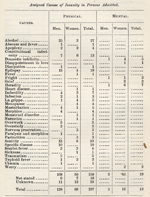At
the turn of the century, insanity was not the only illness that Vermont’s
mental hospitals were faced with; tuberculosis was an issue at both Waterbury
and Brattleboro. The State Hospital at Waterbury (VSH) even proposed the
creation of a cottage on a separate part of the hospital grounds where patients
with TB could be kept to prevent them from infecting the other patients.
A new cottage for the patients was not the only building proposed; there
was also a great push to build a home on the hospital grounds for the female
nurses. At this time, the nurses were not only participating in ward life,
but they were furthering their education at Waterbury as well. The nursing
school, which was established in 1899, graduated 11 nurses in 1901 and 5
nurses in 1902. Simply attending the nursing school, however, did not ensure
that the attendants would stay at the hospital. In fact, only 4 of the 16
graduates were employed at VSH in 1902.
While Waterbury was still in its infancy
at this point, Brattleboro was well established and committed to the “care
of hopelessly insane, maniacal, paranoiac, melancholic, epileptic and general
paralytics.” Brattleboro was able to discharge numerous patients into
the care of Waterbury, however, resulting in an astounding 524 patients
at the turn of the century at Waterbury, but only 281 patients at Brattleboro,
all of whom were either fully paying private clients or state subsidized
patients. Brattleboro still maintained that the best treatment for the insane
was, if possible, to spend time outdoors and active. For the women there
were vegetable and flower gardens, croquet grounds, lawn-tennis and even
a covered veranda for use in stormy weather. For the men there was a hillside
park of 30 acres and 2 miles of paths which extended out of sight of the
institution. |
| According
to the Brattleboro superintendent’s report in 1902, 45% of patients
were chronically insane upon admittance. The majority of the patients were
also elderly, and thus the hospital could have been equated to something
similar to our modern day homes for the elderly; 111 of a 281 patients were
at least 50 years old upon admittance, and at the turn of the century the
average life expectancy was barely 50 years old! The superintendent noted
that the majority of the patients under his care were admitted for senile
insanity with no hope of a cure. This furthers the notion that our modern
concept of an insane asylum does not quite match up with the original reality.
|

Principal
Psychoses 1900
[click
image to enlarge]
|
|
